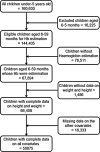Effects of deworming medication on anaemia among children aged 6-59 months in sub-Saharan Africa
- PMID: 35016722
- PMCID: PMC8753868
- DOI: 10.1186/s13071-021-05123-4
Effects of deworming medication on anaemia among children aged 6-59 months in sub-Saharan Africa
Abstract
Background: Despite the limited knowledge regarding the effects of deworming medication (DM) on nutritional indicators in sub-Saharan Africa (SSA), deworming programmes continue to be implemented in resource-limited countries. Therefore, the current study aimed to examine the effects of DM on anaemia among children aged 6-59 months in SSA.
Methods: The analysis was performed using data obtained from 17 demographic and health surveys (DHSs) conducted in SSA. Children were considered to be anaemic if their haemoglobin (Hb) concentration was less than 11.0 g/dl, adjusting for altitude. To account for both multiple measures at the cluster level and the clustering of children within the same country, generalized linear mixed models were used to analyse the anaemia outcomes in 50,075 children aged 6-59 months.
Results: Overall, anaemia was reported in 61.8% of the children, and their median Hb concentration was 10.5 g/dl (interquartile range 9.4-11.5). The prevalence of anaemia ranged from 34.5% in Rwanda to 81.1% in Mali. Multivariate analyses showed that children who did not receive DM had increased odds of being anaemic (adjusted odds ratio [aOR]: 1.11; 95% confidence interval [CI] 1.07-1.16).
Conclusions: The current study revealed that DM can decrease the risk of anaemia among preschool-age children (pre-SAC) in SSA. Thus, tailored public health programmes aimed at reducing childhood anaemia need to consider deworming. However, longitudinal studies are needed to validate the association that has been reported in this cross-sectional study.
Keywords: Anaemia; Coverage; Deworming medication; Haemoglobin; Sub-Saharan Africa.
© 2021. The Author(s).
Conflict of interest statement
The authors declare that they have no competing interests.
Figures





Similar articles
-
Individual, maternal and household risk factors for anaemia among young children in sub-Saharan Africa: a cross-sectional study.BMJ Open. 2018 May 14;8(5):e019654. doi: 10.1136/bmjopen-2017-019654. BMJ Open. 2018. PMID: 29764873 Free PMC article.
-
The Effects of Deworming and Multiple Micronutrients on Anaemia in Preschool Children in Bangladesh: Analysis of Five Cross-Sectional Surveys.Nutrients. 2021 Dec 29;14(1):150. doi: 10.3390/nu14010150. Nutrients. 2021. PMID: 35011023 Free PMC article.
-
Mapping the risk of anaemia in preschool-age children: the contribution of malnutrition, malaria, and helminth infections in West Africa.PLoS Med. 2011 Jun;8(6):e1000438. doi: 10.1371/journal.pmed.1000438. Epub 2011 Jun 7. PLoS Med. 2011. PMID: 21687688 Free PMC article.
-
Investigating the spatial variation and risk factors of childhood anaemia in four sub-Saharan African countries.BMC Public Health. 2020 Jan 29;20(1):126. doi: 10.1186/s12889-020-8189-8. BMC Public Health. 2020. PMID: 31996196 Free PMC article.
-
A Scoping Review of the Risk Factors Associated with Anaemia among Children Under Five Years in Sub-Saharan African Countries.Int J Environ Res Public Health. 2020 Nov 27;17(23):8829. doi: 10.3390/ijerph17238829. Int J Environ Res Public Health. 2020. PMID: 33261060 Free PMC article.
Cited by
-
Childhood Anemia in Mozambique: A Multilevel Mixed-Effects Analysis of 2011-2022/23 Population-Based Surveys.Healthcare (Basel). 2025 Mar 14;13(6):635. doi: 10.3390/healthcare13060635. Healthcare (Basel). 2025. PMID: 40150485 Free PMC article.
-
Decreased Weight-for-Age Associated with Mass Deworming among Young Ethiopian Schoolchildren in Jimma Town, Southwest Ethiopia: A School-Based Cross-Sectional Study.Am J Trop Med Hyg. 2023 Dec 11;110(1):103-110. doi: 10.4269/ajtmh.23-0376. Print 2024 Jan 3. Am J Trop Med Hyg. 2023. PMID: 38081046 Free PMC article.
-
Prevalence of Diarrhea, Intestinal Parasites, and Associated Factors Among Under-Five Children in Dabat District, Northwest Ethiopia: Multicenter Cross-sectional Study.Environ Health Insights. 2023 May 9;17:11786302231174744. doi: 10.1177/11786302231174744. eCollection 2023. Environ Health Insights. 2023. PMID: 37187706 Free PMC article.
-
Household environment associated with anaemia among children aged 6-59 months in Ethiopia: a multilevel analysis of Ethiopia demographic and health survey (2005-2016).BMC Public Health. 2024 Jan 29;24(1):315. doi: 10.1186/s12889-024-17780-y. BMC Public Health. 2024. PMID: 38287295 Free PMC article.
-
Effect of Deworming on Health Outcomes among Children Aged 12-59 Months in Tanzania: A Multilevel Mixed Effects Analysis.J Nutr Metab. 2023 Jul 21;2023:9529600. doi: 10.1155/2023/9529600. eCollection 2023. J Nutr Metab. 2023. PMID: 37520400 Free PMC article.
References
-
- World Health Organization (WHO). Soil-transmitted helminth infections. Geneva: WHO; 2020. https://www.who.int/news-room/fact-sheets/detail/soil-transmitted-helmin... helminth infections are among the most common infections, areas where sanitation is poor. Accessed 27 Jan 2020.
-
- Bethony J, Brooker S, Albonico M, Geiger SM, Loukas A, Diemert D, et al. Soil-transmitted helminth infections: ascariasis, trichuriasis, and hookworm. Lancet. 2006;367:1521–1532. - PubMed
-
- World Health Organization (WHO). Neglected tropical diseases. Geneva: WHO; 2017. https://www.who.int/neglected_diseases/news/WHO_publishes_recommendation.... Accessed 28 Jan 2021.
-
- World Health Organization (WHO) Deworming to combat the health and nutritional impact of soil-transmitted helminths. Geneva: WHO; 2012.
-
- World Health Organization (WHO). Preventive chemotherapy to control soil-transmitted helminth infections in at-risk population groups. Geneva: WHO; 2017. http://www.who.int/elena/titles/full_recommendations/deworming/en/. Accessed 28 Jan 2021. - PubMed
MeSH terms
Substances
LinkOut - more resources
Full Text Sources
Medical
Research Materials

